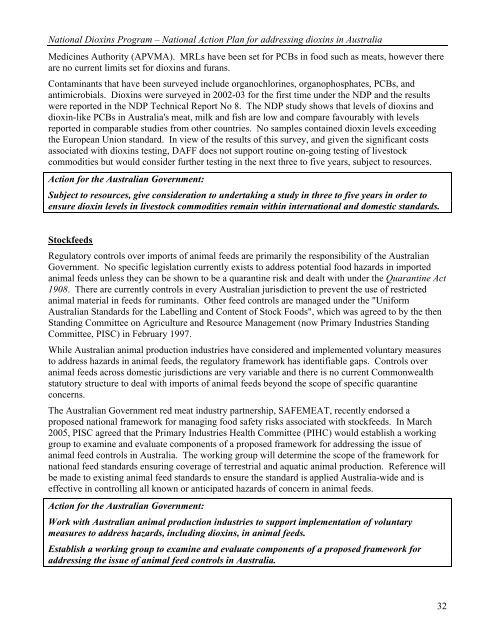National Action Plan for Addressing Dioxins in Australia
National Action Plan for Addressing Dioxins in Australia
National Action Plan for Addressing Dioxins in Australia
- No tags were found...
Create successful ePaper yourself
Turn your PDF publications into a flip-book with our unique Google optimized e-Paper software.
<strong>National</strong> <strong>Diox<strong>in</strong>s</strong> Program – <strong>National</strong> <strong>Action</strong> <strong>Plan</strong> <strong>for</strong> address<strong>in</strong>g diox<strong>in</strong>s <strong>in</strong> <strong>Australia</strong>Medic<strong>in</strong>es Authority (APVMA). MRLs have been set <strong>for</strong> PCBs <strong>in</strong> food such as meats, however thereare no current limits set <strong>for</strong> diox<strong>in</strong>s and furans.Contam<strong>in</strong>ants that have been surveyed <strong>in</strong>clude organochlor<strong>in</strong>es, organophosphates, PCBs, andantimicrobials. <strong>Diox<strong>in</strong>s</strong> were surveyed <strong>in</strong> 2002-03 <strong>for</strong> the first time under the NDP and the resultswere reported <strong>in</strong> the NDP Technical Report No 8. The NDP study shows that levels of diox<strong>in</strong>s anddiox<strong>in</strong>-like PCBs <strong>in</strong> <strong>Australia</strong>'s meat, milk and fish are low and compare favourably with levelsreported <strong>in</strong> comparable studies from other countries. No samples conta<strong>in</strong>ed diox<strong>in</strong> levels exceed<strong>in</strong>gthe European Union standard. In view of the results of this survey, and given the significant costsassociated with diox<strong>in</strong>s test<strong>in</strong>g, DAFF does not support rout<strong>in</strong>e on-go<strong>in</strong>g test<strong>in</strong>g of livestockcommodities but would consider further test<strong>in</strong>g <strong>in</strong> the next three to five years, subject to resources.<strong>Action</strong> <strong>for</strong> the <strong>Australia</strong>n Government:Subject to resources, give consideration to undertak<strong>in</strong>g a study <strong>in</strong> three to five years <strong>in</strong> order toensure diox<strong>in</strong> levels <strong>in</strong> livestock commodities rema<strong>in</strong> with<strong>in</strong> <strong>in</strong>ternational and domestic standards.StockfeedsRegulatory controls over imports of animal feeds are primarily the responsibility of the <strong>Australia</strong>nGovernment. No specific legislation currently exists to address potential food hazards <strong>in</strong> importedanimal feeds unless they can be shown to be a quarant<strong>in</strong>e risk and dealt with under the Quarant<strong>in</strong>e Act1908. There are currently controls <strong>in</strong> every <strong>Australia</strong>n jurisdiction to prevent the use of restrictedanimal material <strong>in</strong> feeds <strong>for</strong> rum<strong>in</strong>ants. Other feed controls are managed under the "Uni<strong>for</strong>m<strong>Australia</strong>n Standards <strong>for</strong> the Labell<strong>in</strong>g and Content of Stock Foods", which was agreed to by the thenStand<strong>in</strong>g Committee on Agriculture and Resource Management (now Primary Industries Stand<strong>in</strong>gCommittee, PISC) <strong>in</strong> February 1997.While <strong>Australia</strong>n animal production <strong>in</strong>dustries have considered and implemented voluntary measuresto address hazards <strong>in</strong> animal feeds, the regulatory framework has identifiable gaps. Controls overanimal feeds across domestic jurisdictions are very variable and there is no current Commonwealthstatutory structure to deal with imports of animal feeds beyond the scope of specific quarant<strong>in</strong>econcerns.The <strong>Australia</strong>n Government red meat <strong>in</strong>dustry partnership, SAFEMEAT, recently endorsed aproposed national framework <strong>for</strong> manag<strong>in</strong>g food safety risks associated with stockfeeds. In March2005, PISC agreed that the Primary Industries Health Committee (PIHC) would establish a work<strong>in</strong>ggroup to exam<strong>in</strong>e and evaluate components of a proposed framework <strong>for</strong> address<strong>in</strong>g the issue ofanimal feed controls <strong>in</strong> <strong>Australia</strong>. The work<strong>in</strong>g group will determ<strong>in</strong>e the scope of the framework <strong>for</strong>national feed standards ensur<strong>in</strong>g coverage of terrestrial and aquatic animal production. Reference willbe made to exist<strong>in</strong>g animal feed standards to ensure the standard is applied <strong>Australia</strong>-wide and iseffective <strong>in</strong> controll<strong>in</strong>g all known or anticipated hazards of concern <strong>in</strong> animal feeds.<strong>Action</strong> <strong>for</strong> the <strong>Australia</strong>n Government:Work with <strong>Australia</strong>n animal production <strong>in</strong>dustries to support implementation of voluntarymeasures to address hazards, <strong>in</strong>clud<strong>in</strong>g diox<strong>in</strong>s, <strong>in</strong> animal feeds.Establish a work<strong>in</strong>g group to exam<strong>in</strong>e and evaluate components of a proposed framework <strong>for</strong>address<strong>in</strong>g the issue of animal feed controls <strong>in</strong> <strong>Australia</strong>.32
















